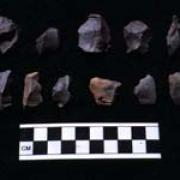The Schoharie Creek II site was identified by museum archaeologists prior to the renovation of Route 7 in the Town of Schoharie, Schoharie County. Mitigation of the site produced artifacts associated with an Early to Middle Woodland camp. This project produced over 40,000 prehistoric artifacts. Twelve prehistoric features, including hearths, postmolds, and charcoal stains, were identified within the project limits. Accelerator mass spectrometry dates deriving from four different features document the site's occupation between 2500 and 1000 B.P. Carbonized plant remains indicate that the site's occupants consumed locally available wild plants (chenopodium, strawberries, wild grapes) and nuts (hazelnut, butternut, and walnut). These plants may have thrived in the wooded areas that aligned Schoharie Creek and may have attracted prehistoric groups to this site. Calcined bone from medium sized mammals and fish scales were also recovered from feature fill and suggest that local fauna and aquatic species were consumed.
The Schoharie Creek II Site
The majority of the artifacts consist of chipped stone tools (bifaces, projectile points, side and end scrapers, unifaces, drills, etc.) and pieces of lithic debitage. Most of these artifacts were manufactured from locally available Onondaga chert. Small flakes manufactured from quartz and Pennsylvania Jasper were also recovered and suggest interaction between the site's occupants and other non-local groups. Ground stone tools, including pitted stones, hammerstones, and netsinkers, and undecorated ceramic sherds were also recovered and point to the use of the site for food processing and resource collection tasks. In addition to formal tools, expedient utilized flakes were used for plant processing.
A later historic occupation was also identified and provides information about the domestic use of the site during the mid to late 19th century. The 19th century is an important period in the history of Schoharie County. This period can be associated with the construction of the Albany-Susquehanna Railroad and the increasing importance of Schoharie County as a producer of agricultural products. Related to these changes were important changes in the socio-economic status and organization of individual households. Analysis of historic artifacts from the Schoharie Creek II site suggest that the site's mid to late 19th century occupants were part of a growing middle-class. The recovery of matched table and teawares suggests that the historic occupants of this site sought to convey their middle-class status to other members of the community through the use of expensive household items. The recovery of non-locally manufactured household and architectural items also suggest that the site's occupants may have also participated in a larger regional economy.






